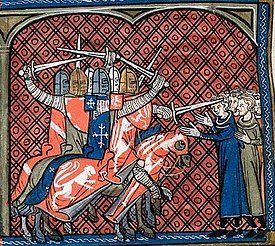
Back Albigensiese Kruistog Afrikaans الحملة الصليبية على الكثار Arabic Cruzada albigense AST Albi müharibələri Azerbaijani آلبیقوی صلیب یوروشو AZB Альбігойскі крыжовы паход Byelorussian Албигойски кръстоносен поход Bulgarian Croada Albigesa Catalan Albigenská křížová výprava Czech Albigensiske korstog Danish
| Albigensian Crusade | |||||||
|---|---|---|---|---|---|---|---|
| Part of the Crusades | |||||||
 Massacre against the Albigensians by the Crusaders | |||||||
| |||||||
| Belligerents | |||||||
| Kingdom of England | ||||||
| Commanders and leaders | |||||||
| # | |||||||
| Casualties and losses | |||||||
| At least 200,000[1] to at most 1,000,000[2] Cathars killed | |||||||
| Considered by some scholars to be an act of genocide against the Cathars, including by the coiner of the word genocide himself, Raphael Lemkin.[3][4] | |||||||
The Albigensian Crusade (French: Croisade des albigeois), also known as the Cathar Crusade (1209–1229), was a military and ideological campaign initiated by Pope Innocent III to eliminate Catharism in Languedoc, what is now southern France. The Crusade was prosecuted primarily by the French crown and promptly took on a political aspect. It resulted in the significant reduction of practicing Cathars and a realignment of the County of Toulouse with the French crown. The distinct regional culture of Languedoc was also diminished.
The Cathars originated from an anti-materialist reform movement within the Bogomil churches of the Balkans calling for what they saw as a return to the Christian message of perfection, poverty and preaching, combined with a rejection of the physical. The reforms were a reaction against the often perceived scandalous and dissolute lifestyles of the Catholic clergy. Their theology, Gnostic in many ways, was basically dualist. Several of their practices, especially their belief in the inherent evil of the physical world, conflicted with the doctrines of the Incarnation of Christ and Catholic sacraments. This led to accusations of Gnosticism and attracted the ire of the Catholic establishment. They became known as the Albigensians because many adherents were from the city of Albi and the surrounding area in the 12th and 13th centuries.
Between 1022 and 1163, the Cathars were condemned by eight local church councils, the last of which, held at Tours, declared that all Albigenses should be put into prison and have their property confiscated. The Third Lateran Council of 1179 repeated the condemnation. Innocent III's diplomatic attempts to roll back Catharism were met with little success. After the murder of his legate Pierre de Castelnau in 1208, and suspecting that Raymond VI, Count of Toulouse was responsible, Innocent III declared a crusade against the Cathars. He offered the lands of the Cathar heretics to any French nobleman willing to take up arms.
From 1209 to 1215, the Crusaders experienced great success, capturing Cathar lands and systematically crushing the movement. From 1215 to 1225, a series of revolts caused many of the lands to be regained by the Cathars. A renewed crusade resulted in the recapturing of the territory and effectively drove Catharism underground by 1244. The Albigensian Crusade had a role in the creation and institutionalization of both the Dominican Order and the Medieval Inquisition. The Dominicans promulgated the message of the Church and spread it by preaching the Church's teachings in towns and villages to stop the spread of heresies, while the Inquisition investigated people who were accused of teaching heresies. Because of these efforts, all discernible traces of the Cathar movement were eradicated by the middle of the 14th century. Some historians consider the Albigensian Crusade against the Cathars an act of genocide.[3][4]
- ^ Tatz & Higgins 2016, p. 214.
- ^ Robertson 1902, p. 254.
- ^ a b Lemkin 2012, p. 71.
- ^ a b Pegg 2008, p. 195.